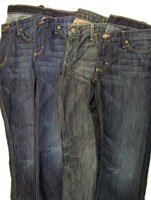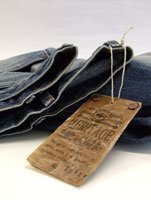Keeping Pace With Denim Demand and Design
Denim North America looks to the future with a nod to denim’s roots.
A call to Denim North America’s headquarters in Columbus, Ga., yields an automated voicemail system that quickly dispenses with the usual departments—shipping, customer service and accounts payable—and heads right to the technical directory: weave room, finishing and picks, beaming, warping and dyeing, and product and market development.
The company has operated largely under the radar since opening in 2002 on the grounds of a former Marubeni factory. But now, as one of the two remaining denim mills in the United States, Denim North America (DNA) is raising its visibility a bit. In early March, the company exhibited at its first trade show, the Kingpins boutique denim sourcing show in Los Angeles. DNA has operated a Los Angeles office since the company was founded, and the company was already familiar with many of the attendees at Kingpins. Still, results were encouraging, and the company plans to attend the next Kingpins show, set for July in New York.
DNA—which also operates offices in New York, San Francisco and Mexico City—was founded in the wake of the economic downturn of 2001, at a time when many U.S. textile companies were closing shop or looking abroad for new business opportunities. DNA’s ability to survive—and thrive—during that downturn bodes well for the company’s success in navigating the current crisis. DNA President Monte Galbraith, an affable man with a fondness for textile puns, conceded that the current economy bears little resemblance to the 2001–2002 slowdown. Still, the company’s founding years helped shape the strategy for the current economic climate. DNA saw the indications of a slowdown and began preparing in advance, trimming inventory and developing new products.
“We come from that mindset of what doesn’t kill you makes you stronger,” Galbraith said.
California Apparel News Executive Editor Alison A. Nieder recently caught up with Galbraith to discuss the company, its plans for the future and how California fits into its goals.
How does California fit into Denim North America’s business strategy?
You can hardly say “denim” without saying “California.” The terms are—if you pardon the pun—interwoven.
Our L.A. office is the nerve center to keep us posted on what’s happening in the industry.
California has always been an important part of our plan simply because so many important denim brands—large, small and emerging—originated there. California has a very high level of denim sensibility. Denim jeans started in California, and many of the very best ideas for denim innovation still originate in California. Frankly, when most of the world thinks of California, they think of cool blue jeans, great cars and pretty girls. It doesn’t get much better than that. California and denim go hand in hand.
I still say the best ideas come out of California. [All the designers] do their annual [buying trips]—what I call the “globe trot.” They’ll tell me the best stuff they find is in L.A.With several notable exceptions—such as Levi’s, Guess, Gap and Seven For All Mankind—many West Coast denim makers are small- to mid-sized companies. Is DNA able to cater to the smaller players as well as the large companies?
In our business plan, we plan to do 20 million to 21 million yards per year. That’s a lot of denim. You’ve got to deal with the larger people, but we have a flexible manufacturing facility and we try to find a way to work with companies. We try as best we can to support smaller brands because we have a soft spot for growing and innovative companies that are paddling hard against the current.
However, we cannot be all things to all people, and we have to make tough choices and turn down orders that do not make good business sense in either the long- or short-term view. That said, we are always listening and watching for the next great trend and idea, so we try to stay in contact with as many new designers as possible. You never know when one might hit on a great new idea.The company was founded during an economic downturn. How does the current economic climate compare, and how is the company positioning itself to succeed?
Denim North America was founded in May of 2002, so we have been building our business now for seven years.
We learned a lot of things that will help us weather this storm. We can be very aggressive on the one hand and very conservative on inventory management. Inventory has always been the key. You’ve got to watch every penny. Inventory is cash. I always say we’re really in the cash-management business—we just happen to make textiles.
We probably have the best cost-control systems in the industry as well as an incredibly well-engineered and flexible manufacturing setup. Our focus is on product innovation and customer intimacy. We spend a lot of time with strategic accounts, developing customized products that fit their objectives for each new season as well as independently developing ideas gleaned from emerging trends. This is an ongoing process. Innovation, cost control, manufacturing excellence and customer intimacy make up the cornerstones of our business. There are some who believe we’ve seen the end of the premium-denim boom—and others who are banking on resurgence, possibly at a lower price point. Where do you see the denim market heading?
I don’t know if anyone really has an answer to that.
I think there is a sag in ultra-premium-denim expectations. In this environment, who isn’t thinking about what they need vs. what they want? That said, I truly believe that a new pair of great-looking and great-fitting blue jeans is the one garment that is so universally loved that great jeans will always sell even though “premium” might be at a somewhat lower price point than in the last few years. Lets face it, $300 to $400 jeans did not make much sense when times were “good.” They really don’t make sense now that times are tough.
However, there will be continued demand for premium/better jeans when the economy does start to pick back up. I think a great pair of new “premium” jeans will be on a lot of people’s radar screen this year—and many more to come.
I really believe that for great jeans—let’s say [retail priced between] $90 to the high $100s—there will always be a demand. I think people are re-evaluating what they’re spending. You can focus on better blue jeans—it’s still premium, just not uber-premium. Keep the focus on fit and finish. You can spend $5 to $6 on fabric and be very successful.
If there’s one piece of clothing you can buy and be emotionally attached to, it’s blue jeans. Tell me about the Heritage Collection.
Denim is an iconic fabric, and Heritage was a nod to the past, a nod to the kind of fabrics worn by the miners and sailors 100 years ago. There is not another garment more associated with the United States than blue jeans.
Other countries have picked up on denim over the years and have developed their own versions. Over the years, there has developed a myth that only denim from overseas has better quality. The fact of the matter is that fabric from overseas is only more expensive. They have done a great job marketing their products, and my hat is off to them.
Heritage was a marketing tool to remind people where it came from, how it’s woven into our lives, if you will.
For information about DNA, call Daryl Mead, senior account manager in the Los Angeles office, or visit www.denimna.com.
























